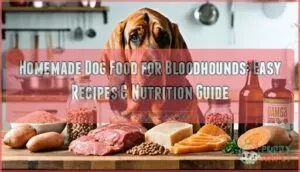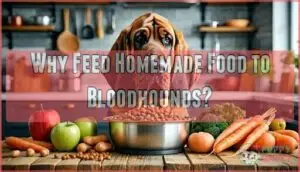This site is supported by our readers. We may earn a commission, at no cost to you, if you purchase through links.

These scent hounds need 2,100-2,800 calories daily, with high-quality proteins like lean beef, chicken, and fish forming the foundation.
Their large frames require careful calcium-to-phosphorus ratios to support bone health, while their active noses benefit from omega-3 fatty acids.
Start with simple recipes combining 50% protein, 25% vegetables, and 25% carbohydrates like sweet potatoes or brown rice.
Always switch gradually over 7-10 days to avoid digestive upset.
The real magic happens when you understand how specific ingredients can enhance everything from coat shine to joint mobility.
Table Of Contents
- Key Takeaways
- Bloodhound Homemade Dog Food Benefits
- Why Feed Homemade Food to Bloodhounds?
- Risks of Homemade Dog Food for Bloodhounds
- Dietary Changes for Bloodhound Health
- Calorie Requirements for Bloodhounds
- Homemade Dog Food for Bloodhound Puppies
- Delivery Service for Homemade Dog Food
- Tips for Making Bloodhound Homemade Dog Food
- Frequently Asked Questions (FAQs)
- What is the best food to feed a Bloodhound?
- What do vets recommend for homemade dog food?
- Can I feed my dog chicken and rice every day?
- What do vets think of homemade dog food?
- How often should I feed chicken feet to my small dog?
- How do I keep the grinding parts of my Weston grinder from rusting?
- What is the shelf life of homemade dog food supplements?
- How often should I transition between recipes?
- Can bloodhounds eat homemade food exclusively?
- What kitchen equipment is needed for preparation?
- Conclusion
Key Takeaways
- You’ll need to provide 2,100-2,800 calories daily with 50% protein intake, 25% vegetables, and 25% carbohydrates to meet your bloodhound’s high energy demands
- You must maintain a calcium-to-phosphorus ratio between 1.2:1 and 1.4:1, adding 800-1,000 mg of calcium per pound of meat to support your dog’s large bone structure
- You should transition gradually over 7-10 days when switching to homemade food to prevent digestive upset and allow your bloodhound’s system to adjust
- You’ll see improvements in coat shine, joint mobility, and energy levels within weeks, with studies showing homemade diets can extend your dog’s lifespan by up to 20%
Bloodhound Homemade Dog Food Benefits
You’ll discover that homemade dog food offers your Bloodhound superior nutrition control and can address specific health concerns like allergies, joint issues, and digestive problems.
Research shows that 94% of dogs with gastrointestinal or skin disorders benefit from carefully prepared homemade diets, while many experience improved coat condition and reduced health complications.
Health Benefits of Homemade Dog Food for Bloodhounds
When you prepare homemade dog food for your bloodhound, you’re giving them a nutritional advantage that commercial kibble simply can’t match.
Fresh, whole ingredients support your dog’s health in remarkable ways.
Here are the key health benefits you’ll notice:
- Improved Digestion – Homemade meals reduce gastrointestinal upset and create firmer, less frequent stools
- Reduced Allergies – Eliminating artificial additives and preservatives decreases skin irritations and food sensitivities
- Healthy Joints – Fresh meats and controlled portions help maintain ideal weight, reducing arthritis risk
- Balanced Nutrition – Real ingredients provide better bioavailability than processed alternatives
- Increased Longevity – Studies show homemade diets can extend lifespan by up to 20% compared to commercial food
Using a homemade dog food approach gives you complete control over what goes into your dog’s bowl, ensuring they get the healthy dog food they deserve.
This natural approach to bloodhound nutrition gives you complete control over what goes into your dog’s bowl, ensuring they get the healthy dog food they deserve.
Nutritional Guidelines for Bloodhound Homemade Dog Food
When planning homemade dog food for your Bloodhound, understanding proper nutritional guidelines guarantees your pup thrives on every meal.
Adult Bloodhounds need 18–25% protein and 10–15% fat by dry matter to maintain their impressive muscle mass and glossy coat.
Your meal planning should focus on achieving the right nutrient balance.
Maintain a calcium-to-phosphorus ratio between 1.2:1 and 1.4:1, adding 800-1,000 mg of calcium per pound of meat.
Carbohydrates should comprise 30–60% of total calories from digestible sources like rice and sweet potatoes.
| Nutrient Category | Recommended Amount |
|---|---|
| Protein | 18-25% by dry matter |
| Fat | 10-15% by dry matter |
| Calcium:Phosphorus | 1.2:1 to 1.4:1 ratio |
Rotate protein sources including chicken, turkey, and beef while incorporating organ meats.
Raw diets require extra caution for bacterial contamination.
Vitamin supplements fill nutritional gaps that homemade meals might miss.
Always consult your veterinarian before switching your Bloodhound’s diet, as these gentle giants have specific nutritional needs that support their active tracking lifestyle.
Ensuring the right Bloodhound Nutrition is vital for their overall health and well-being.
Homemade Dog Food Recipes for Bloodhounds
Your bloodhound thrives on homemade dog food recipes that balance nutrition with taste.
A chicken, brown rice, and vegetable recipe delivers 36% protein for muscle health, while turkey and quinoa meals provide heart-healthy omega fatty acids.
Raw feeding requires careful food safety protocols, but proper meal prep guarantees nutrient balance. These natural dog food ingredients support your bloodhound’s specific dietary needs better than commercial alternatives.
Considering the benefits of homemade dog food, owners often research dog food products to find the best ingredients for their pets, focusing on a balanced diet.
Why Feed Homemade Food to Bloodhounds?
When choosing homemade dog food for your bloodhound, you’re taking control of their nutrition in ways commercial kibble can’t match.
Fresh ingredients allow you to avoid mystery additives while ensuring your pup gets exactly what they need. Custom diets let you tailor meals to your bloodhound’s specific health requirements, supporting ideal dog wellness through thoughtful nutrient balance.
Your bloodhound’s natural dog food journey offers these compelling advantages:
- Superior ingredient quality – You control every component that goes into their bowl
- Healthy weight management – Precise portion control prevents obesity-related joint issues
- Allergy prevention – Eliminate problematic ingredients found in processed foods
- Enhanced longevity – Studies show homemade diets can increase lifespan by 20%
Raw dog food and cooked homemade meals both support bloodhound health better than processed alternatives. The bloodhound diet benefits from this personalized approach, giving you confidence that every meal contributes to their long-term wellness.
Risks of Homemade Dog Food for Bloodhounds
While homemade dog food offers numerous benefits, you’ll face several homemade dog food risks if you’re not careful.
Nutritional needs of Bloodhounds require precise planning, and inadequate or dangerous recipes can create serious problems.
Nutrient deficiency stands as the biggest threat.
Many homemade recipes lack vitamins, minerals, or amino acids your Bloodhound needs.
Without proper calcium-to-phosphorus ratios, your dog might develop bone issues.
Protein imbalances can affect muscle development and energy levels.
Contamination risk increases when you handle raw ingredients improperly.
Bacteria like Salmonella can make both you and your dog sick.
Unsafe or harmful ingredients pose another danger—foods like onions, garlic, and chocolate are toxic to dogs.
Dietary imbalance occurs when you change recipes without understanding nutritional impacts.
What seems like a small substitution might eliminate important nutrients.
Allergic reactions can develop from new ingredients you haven’t tested.
Overfeeding or underfeeding becomes likely without measuring portions correctly, leading to obesity or malnutrition.
To avoid these issues, it’s vital to follow proper homemade dog food guidelines to guarantee your Bloodhound receives a balanced diet.
Dietary Changes for Bloodhound Health
Your Bloodhound’s health can dramatically improve through strategic dietary changes for Bloodhound health.
Switching to homemade dog food for bloodhounds addresses multiple concerns simultaneously while providing superior nutrient balance compared to commercial options.
- Combat Food Allergies: Remove common triggers like corn, wheat, and artificial preservatives that cause chronic itching and digestive issues in sensitive bloodhounds.
- Support Obesity Management: Control portions and ingredients to maintain ideal weight, reducing strain on joints prone to hip dysplasia and arthritis.
- Enhance Health Supplements: Add targeted nutrients like omega-3 fatty acids and probiotics to address specific conditions while supporting overall wellness through proper nutritional needs of Bloodhounds.
Calorie Requirements for Bloodhounds
Determining your Bloodhound’s Daily Caloric Needs requires careful consideration of multiple factors that influence their Energy Requirements.
Adult Bloodhounds typically need 1,100-1,300 calories daily, but this varies substantially based on individual circumstances.
| Bloodhound Type | Weight Range | Daily Calories |
|---|---|---|
| Sedentary Adult | 80-100 lbs | 900-1,100 kcal |
| Active Adult | 80-100 lbs | 1,200-1,400 kcal |
| Working/Tracking | 80-100 lbs | 1,400-1,600 kcal |
| Senior Dog | 80-100 lbs | 880-1,040 kcal |
| Overweight Dog | 80-100 lbs | 960-1,120 kcal |
For accurate Calorie Calculation, use this formula: 70 × (body weight in kg)^0.75 for resting energy requirements.
Working dogs need 20-40% more calories than couch potatoes.
Male Bloodhounds require 10-15% more calories than females of similar size.
When preparing homemade dog food for Bloodhounds, measure portions carefully and monitor your dog’s weight every 2-4 weeks.
Adjust calories based on body condition scoring to maintain ideal health through proper calorie control.
Homemade Dog Food for Bloodhound Puppies
During your Bloodhound’s growth stages, puppy nutrition requires careful attention to balance.
Your growing Bloodhound needs precise nutrition during crucial development months.
Your homemade dog food for Bloodhounds should meet AAFCO’s 22% protein and 8% fat requirements.
Establish a consistent feeding schedule with proper diet shift over 7-10 days when switching from commercial food.
Include calcium at 1.2-1.5% dry matter and phosphorus at 0.9-1.1% to support bone development.
Consider puppy supplements like DHA for cognitive growth.
Homemade diets allow precise control over ingredients during these critical developmental months for your growing Bloodhound.
Delivery Service for Homemade Dog Food
When juggling the demands of raising a Bloodhound puppy, busy pet parents often find relief through professional meal kits and food subscription services.
These homemade delivery options eliminate the guesswork while maintaining nutritional quality your growing pup needs.
Services like Nom Nom lead the fresh food diets revolution, offering veterinary-formulated dog food recipes using human-grade ingredients.
These pet food boxes arrive with perfectly portioned meals customized to your Bloodhound’s weight, age, and activity level.
Fresh recipes avoid artificial preservatives that can trigger allergies in sensitive breeds.
The U.S. fresh pet food delivery market is booming, projected to hit $1.3 billion by 2027.
Subscription-based models account for over 60% of transactions, with 9 out of 10 customers reporting improved coat shine and energy levels in their Bloodhounds.
Most services offer flexible delivery schedules – weekly, biweekly, or monthly – with cold-chain logistics maintaining food safety.
While pricier than DIY approaches, delivery services save time and provide consistent quality control that homemade dog food preparation demands.
Tips for Making Bloodhound Homemade Dog Food
Making homemade dog food for Bloodhounds successfully requires careful attention to Food Safety and Nutrient Balance. Whether you’re meal planning weekly batches or preparing daily portions, these DIY dog food fundamentals guarantee your Bloodhound thrives on homemade nutrition.
Essential tips for bloodhound homemade food tips include:
- Ingredient Selection: Use lean proteins like chicken, turkey, or beef with low-oxalate vegetables
- Cooking Methods: Steam or boil ingredients to retain nutrients while maintaining thorough cooking
- Meal Planning: Grind all meat and bones, puree vegetables for easier digestion
- Food Safety: Store portions in airtight containers, refrigerate up to three days
Follow the 80/10/10 rule: 80% muscle meat, 10% organs, 10% bone. Add 800-1,000 mg calcium per pound of meat. This approach creates the best homemade food for Bloodhounds while maintaining proper canine nutrition standards.
Frequently Asked Questions (FAQs)
What is the best food to feed a Bloodhound?
High-quality protein builds muscle, healthy fats fuel energy, controlled portions prevent bloat.
You’ll want lean meats, whole grains, and vegetables that support your Bloodhound’s active lifestyle while avoiding obesity-related joint problems.
What do vets recommend for homemade dog food?
Vets recommend consulting them before switching to homemade diets. You’ll need balanced recipes with proper protein-to-fat ratios, calcium supplementation, and regular nutritional monitoring to prevent deficiencies.
Can I feed my dog chicken and rice every day?
While 70% of dogs show improved coat condition on homemade diets, you shouldn’t feed chicken and rice daily.
This simple combination lacks essential nutrients, vitamins, and minerals your dog needs for peak health and can cause nutritional deficiencies over time, which is why a homemade diet should be carefully planned.
What do vets think of homemade dog food?
Veterinary professionals have mixed feelings about homemade diets.
While they appreciate owners’ dedication to their pets’ nutrition, they’re concerned about nutritional imbalances.
Most vets recommend consulting professionals before switching to guarantee your dog gets complete, balanced meals.
How often should I feed chicken feet to my small dog?
Offer chicken feet once or twice weekly as treats for your small dog.
They’re rich in glucosamine and collagen, supporting joint health.
Limit portions to prevent digestive upset from their high fat content.
How do I keep the grinding parts of my Weston grinder from rusting?
Like a shield protecting precious metal, proper care keeps your Weston grinder’s parts rust-free.
After each use, thoroughly dry all grinding components and apply a thin coating of food-grade mineral oil to metal surfaces before storing.
What is the shelf life of homemade dog food supplements?
Homemade supplement shelf life varies by type and storage.
Powdered supplements last 12-18 months when stored properly in cool, dry places.
Oil-based supplements expire within 6-12 months and need refrigeration to prevent rancidity.
How often should I transition between recipes?
Picture your bloodhound’s tail wagging with anticipation as you present their favorite meal, knowing variety keeps mealtimes exciting.
You should switch between recipes every 7-14 days, allowing your dog’s digestive system to adjust while preventing boredom and ensuring balanced nutrition.
Can bloodhounds eat homemade food exclusively?
Yes, bloodhounds can thrive on homemade food exclusively when properly balanced. You’ll need veterinary guidance to guarantee complete nutrition, proper calcium-phosphorus ratios, and adequate supplements for peak health.
What kitchen equipment is needed for preparation?
Creating culinary magic requires the right tools in your arsenal.
You’ll need a food processor, meat grinder, kitchen scale, cutting boards, sharp knives, mixing bowls, and storage containers for safe preparation and portioning.
This arsenal is essential for complete concepts like safe preparation and portioning to come together seamlessly.
Conclusion
Creating homemade dog food for bloodhounds requires dedication while commercial options offer convenience, yet the health benefits you’ll witness make every effort worthwhile.
You’ve learned that proper nutrition transforms these gentle giants from sluggish companions into vibrant, energetic partners.
Your bloodhound’s improved coat shine, enhanced joint mobility, and boosted energy levels will confirm you’re on the right track.
Remember to switch gradually, maintain proper calcium-to-phosphorus ratios, and consult your veterinarian regularly.
Making homemade dog food for bloodhounds isn’t just feeding—it’s investing in your companion’s longevity and vigor.











